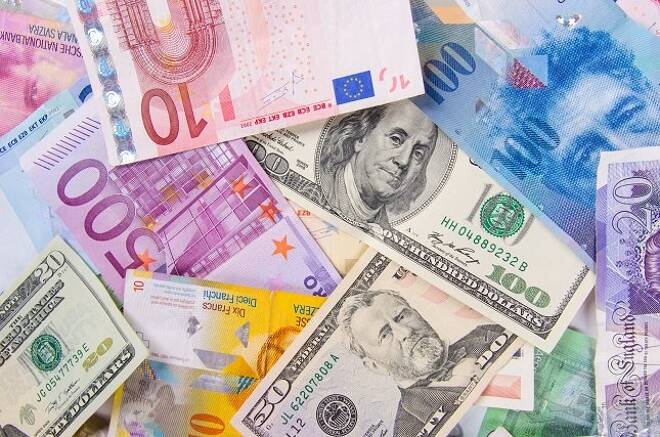Advertisement
Advertisement
EUR/USD Daily Technical Analysis for May 1, 2017
By:
There was a deluge of European data on Friday, headlined by stronger than expected European inflation which was telegraphed on Thursday as German released
There was a deluge of European data on Friday, headlined by stronger than expected European inflation which was telegraphed on Thursday as German released country and state inflation figures. The currency pair rose to the top end of the range, but was unable to pierce through resistance levels, and closed well off the highs of the session.
Technicals
The EUR/USD rose to test resistance at 1.0955, but fell short notching up a high on Friday of 1.0947. The exchange rate is forming a bull flag pattern that is a pause that refreshes. Bulls might need to wait for the completion of the second round of the French elections before the currency pair hits a fresh high. Support is seen near a downward sloping trend line that was the former breakout level now coming in near 1.0820. Additional support on the currency pair is seen near the 10-day moving average at 1.0798.
Momentum remains positive as the MACD (moving average convergence divergence) index prints in the black with an upward sloping trajectory reflected by the MACD histogram. This reflects accelerating positive momentum, which points to a higher exchange rate. The upward movement of the RSI (relative strength index) and the print at 65, which is on the upper end of the neutral range also points to a higher exchange rate.
Eurozone Inflation Remains Robust
Eurozone April inflation jumped back to 1.9% as the timing of Easter help buoy prices. The preliminary reading for Eurozone April HICP inflation came in a tad higher than expected at 1.9% year over year compared to expectations of a 1.8% increase, although this shouldn’t have been a surprise after the stronger than expected numbers out of Spain and Germany.
French Inflation was Somewhat Subdued
French April HICP steady at 1.4% year over year, unchanged from the previous month and no sign of the Easter effect that was so apparent in German and Spanish data yesterday. Rather than coming together Eurozone inflation rates are once again drifting apart and while special factors play a role that doesn’t make Draghi’s life any easier. French PPI inflation meanwhile fell back to 2.9% year over year in March, while February was revised down to 3.7%, with energy price variations playing a role, but also indicating that there are pipeline pressures that should lift even the French headline number in coming months. Also, released, French consumer spending disappointed again in March, although with Q1 GDP already released that mainly adds background information.
German import price inflation fell back to 6.1% year over year in March from 7.4% year over year in February. Lower than anticipated and still a very high number, although the main reason behind the fall back was a sharp deceleration in energy price inflation, which dropped to a still very high 32.8% year over year in March, from 49.7% year over year in the previous month. This backs Draghi’s assertion that inflation remains mainly driven by base effects from energy prices and currency fluctuations. Still excluding energy import prices remain at a high 3.5% year over year, down from 3.7% year over year in February, but still pointing to pipeline inflation pressures ahead.
Spanish Growth Accelerated
Spanish growth unexpectedly accelerates in Q1, with the quarterly growth rate coming in higher than anticipated at 0.8% quarter over quarter, up from 0.7% quarter over quarter in Q4 last year and bringing the annual rate to 3.0% year over year. The Spanish economy continues to outperform and is also benefiting from increased tourism and a gradual rebound in construction and house prices after the slump of the financial crisis. Unemployment remains too high though especially among the under 25s and EU fatigue as elsewhere in the Eurozone is also a risk going ahead, together with remaining problems in the banking sector.
French Growth was Relatively Soft
French Q1 GDP came in a tad weaker than anticipated, with the quarterly growth rate decelerating to 0.3% quarter over quarter, against expectations for a reading of 0.4% quarter over quarter. At the same time Q4 was revised up to 0.5% quarter over quarter. The breakdown for the preliminary number show a sharp acceleration in imports, while exports contracted for the first time since Q2 last year. Price consumption slowed down, but encouragingly investment growth picked up to 0.9% quarter over quarter from 0.6% quarter over quarter. Q2 confidence indicators out of France have been very strong and despite the slight lower than hoped for Q1 GDP number the picture remains of a cyclical recovery in France that should give the next French President the chance to finally press ahead with urgently needed structural reforms.
About the Author
David Beckerauthor
David Becker focuses his attention on various consulting and portfolio management activities at Fortuity LLC, where he currently provides oversight for a multimillion-dollar portfolio consisting of commodities, debt, equities, real estate, and more.
Did you find this article useful?
Latest news and analysis
Advertisement
